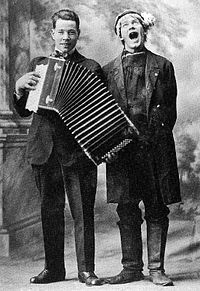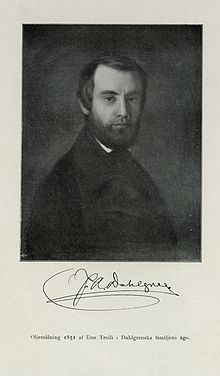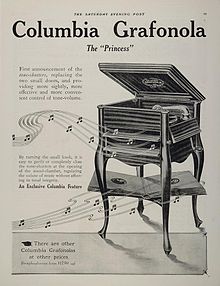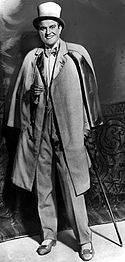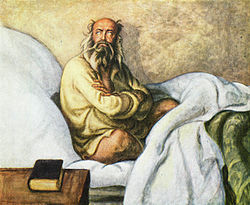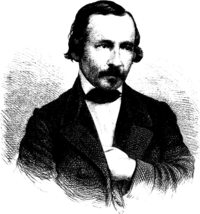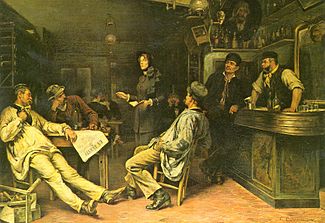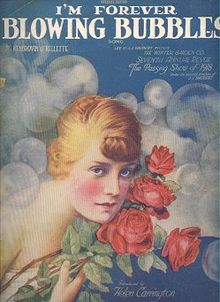- Hjalmar Peterson
-
Contents
Swedish-American entertainer
Olle i Skratthult was the stage name of Hjalmar Peterson, a Swedish-American vaudeville artist, who achieved great popularity during the 1910s and 1920s. Peterson was born February 7, 1886 in the Swedish province of Värmland. Arriving in the United States in 1906, he eventually settled in Minneapolis.[1] At first Peterson worked as a bricklayer in the new country, but before long he embarked on a career as a professional entertainer. In 1909 he returned to Sweden as a member of The Swedish-American Quartet, and during its two-year tour he gathered the songs, stories and jokes he would later use as a solo performer.
Back in America Peterson adopted the persona of Olle i Skratthult (Olle from Laughtersville) and began performing on the Scandinavian-language vaudeville circuit. Olle was a bondkomiker (peasant comic), and he dressed the part with a blacked-out tooth and straw-colored wig. By 1916 he had a touring group, and the following year he married the company’s leading lady, Olga Lindgren.[2]
Olle i Skratthult was a full-time entertainer for most of his adult life and for many years was the most famous performer in Scandinavian vaudeville. During the 1920s he toured the country with a large band and was enthusiastically greeted by both ethnic and mainstream audiences. His touring company also had several actors. An evening’s entertainment often began with a short play, followed by Olle’s songs and stories and ended with a public dance. A full-length theatrical evening was rare unless it was F. A. Dahlgren's musical drama "Värmlänningarna" (The People of Värmland).[3]
A phenomenon
"Last night I decided to try to gain entrance to Tuckerman Hall, and since I did not arrive until 8 o'clock, I would not have been able to get in if it had not been for my press pass. I lost two buttons on my overcoat in the melee, but that did not matter, as long as I finally got a seat — that is I had to be satisfied with standing room in the rear. And, I did something I had never done before, and never expect to do again — unless I go to an "Olle-show" — that is I stood on my two tired feet over two hours — and enjoyed myself. There is a lot of complaining to be heard from theatrical people, to the effect that revenue is falling off and that the radio and the phonographs keep the public at home. Well, the Swedish public at least did not stay at home that night. The hall was packed an hour before the time when it was scheduled to start, and hundreds clamored for admittance in vain. A man, who can attract crowds like that in these days, must be a phenomenon. Of course he does not do all the performing himself; he is ably assisted by his lovely wife, Olga, and by some very clever dancers, and a bunch of virtuosos, who make up the Olle i Skratthult orchestra. It is a splendid aggregation of musicians, to say the least, and I need not add that my tired feet forgot their tired feeling as soon as the first strains from the instruments were heard, and I danced with glee until the "Home, Sweet Home" gave the signal that the show was at an end."
-
- — Burt Maxwell in the Worcester Telegram (MA), reprinted in the Dayton Review (IA) [4]
Later years
Peterson only performed in Swedish, and as the use of that language declined in America so too did his popularity. As the tours became smaller there were fewer musicians and actors to accompany him. At the very end there was only Olle.
Hjalmar and Olga were divorced in 1933. He remarried, and his second marriage produced two children. He stopped touring and appeared only on the radio.
Near the end of his life Peterson underwent a religious conversion and sang hymns under the auspices of the Salvation Army. He died in 1960.[2]
Popular recording artist
Between 1916 and 1929 Olle i Skratthult (Hjalmar Peterson) recorded 46 songs, primarily for Columbia and Victor Records. In addition, the Hjalmar Peterson Orchestra recorded 18 instrumental tracks for Victor. Some of the Victor numbers were subsequently released on the company’s low-priced Bluebird label.
Columbia and Victor always listed Olle under both his real name and his stage name. Some records gave Hjalmar Peterson top billing. Others gave precedence to Olle i Skratthult. Instrumentals were credited to Olle i Skratthults Luffarekapell, Hjalmar Peterson’s Hobo Orchestra and to other similar names. Olle’s own band did not appear on the records, which were made by studio musicians in New York and Chicago. Among the session players were country music pioneer Carson Robison and the celebrated accordion artist Arvid Franzen.
As a recording artist Olle relied on many Swedish songwriters and poets. The most important of these were Lars Bondeson, Jödde i Göljaryd, Göran Svenning, David Hellström, Anna Myrberg, Emil Norlander, Ernst Rolf, Kalle Nämdeman, Skånska Lasse, Gustaf Fröding, Jeremias i Tröstlösa and Fred Winter.[5]
Best known for his comedy, Olle also had romantic waltzes in his repertoire. He recorded, for instance, Malmö Valsen (The Malmö Waltz), written by Svenning and Hellström for the Baltic Exhibition of 1914. [6]
A contemporary recording artist, who had much in common with Olle, was Charles G. Widdén. The classically-trained singer Joel Mossberg took much of his repertoire from the Swedish choral tradition, but he and Olle each recorded several numbers from the songbooks of Lars Bondeson.
Not all of Olle’s songs had Swedish roots. Den Lustige Kopparslagarn (The Jolly Coppersmith), which Olle recorded three times, was of German origin. Barndomshemmet (My Childhood Home) was introduced to American audiences by his wife Olga. It was an adaptation of “On the Banks of the Wabash”, the state song of Indiana. There were other examples of American popular music in Olle’s repertoire. “Just Kiss Yourself Good-Bye” in Swedish became Petters Olycksaliga Frieri (Peter's Unlucky Marriage Proposal). “I'm Forever Blowing Bubbles” was likewise Såpbubblor (Soap Bubbles). “Just Kiss Yourself Good-Bye” was a so-called Coon song, but its racial stereotypes were absent from the Swedish version.
Some of Olle’s final recordings were taken from more traditional sources. In 1928 he recorded the folk song Jag gick mig ut en sommerdag (I went out one summer day). The next year he recorded the broadside ballad Hjalmar och Hulda (Hjalmar and Hulda). These sorrowful tales were a departure from his usual lighthearted fare.[5]
In addition to his records Olle i Skratthult published and sold several songbooks. The small pamphlets included songs he had recorded and other material from his live performances. His 1921 and 1922 songbooks are on file at the Minnesota Historical Society.
Olle i Skratthult will be forever associated with the song Nikolina. He recorded it in 1917 for Columbia and in 1923 and 1929 for Victor. It is estimated that 100,000 copies of the song were sold, a remarkable feat for a foreign-language record.[5]
Nikolina is the tragicomic story of a couple, whose desire for romantic happiness is thwarted by the girl’s autocratic father. The song became enormously popular with immigrant audiences, who strongly identified with the young lovers’ plight. An English version, popularized by Slim Jim and the Vagabond Kid (Ernest and Clarence Iverson), introduced the song to the rest of America.
Foreword to 1908 songbook
Swedes have had the reputation of familiarizing themselves faster than anyone else with the customs and traditions of various countries — to take them in stride.
About two years ago a happy and energetic young man came to this country from the province of Värmland. His name was Hjalmar Peterson, and he had already successfully appeared on stage in his home district under the name of "Olle i Skratthult". But little did he suspect that he would soon establish himself as America's foremost Swedish comedian, storyteller and singer. Like our great American actors and entertainers "Olle i Skratthult" now offers his songs and stories for sale, and it is to be hoped that this little book will do well since it contains many of the choice pieces with which "Olle" has had great success, written by such well-known Swedish humorists as Gustaf Fröding, F.A. Dahlgren and Jödde i Göljaryd.
This book has been published to earn a little extra income and to make “Olle” more familiar to Swedish-American audiences. It is his dearest wish to devote all of his time to the theater instead of the current situation where he carries mortar one day and appears on stage the next.
- Minneapolis, Minn., Sept. 28, 1908.
- OTTO ANDERSON. (Wanderer.)[7]
- Anderson was a traveling correspondent for the Minneapolis newspaper Svenska Folkets Tidning between 1899 and 1911; he used the pen names Otto and Viftare (wanderer) for his reports from various locations.[8]
Renewed interest in Olle i Skratthult
In the 1970s Olle i Skratthult was rediscovered in his native country and in the United States. The Swedish Emigrant Institute of Växsjö, Sweden gave prominent mention to Olle i Skratthult and Charles G. Widdén in a 1973 exhibit on entertainment in Swedish America. A small disc was produced for the occasion with excerpts from their songs and stories.[9]
The Snoose Boulevard Festival was held in the Cedar-Riverside neighborhood of Minneapolis from 1972 through 1977. In the late 19th century Cedar Avenue became known as “Snoose Boulevard”, a nickname often given to the main street in Scandinavian communities. The term derived from the residents’ fondness for snus (snuff), an inexpensive form of tobacco. The event, which celebrated the area’s Scandinavian past, featured the music, food, and arts of the immigrants who had once lived there. It also highlighted the careers of Olle i Skratthult (Hjalmar Peterson), Slim Jim and the Vagabond Kid (Ernest and Clarence Iverson) and the Olson Sisters (Eleonora and Ethel Olson).
Recordings
In conjunction with the festival the Swedish-born singer Anne-Charlotte Harvey recorded three albums of folk tunes, emigrant ballads, hymns, waltzes and comic songs. The non-profit Olle i Skratthult Project sponsored the annual celebration and the recordings. [10] Harvey’s albums, produced by the renowned ethnomusicologist Maury Bernstein, included twelve songs from Olle’s repertoire.[5] In 1976 the Olle i Skratthult Project reissued two of Olle's most popular recordings as a single: Nikolina and Flickan På Bellmansro.
Banjar Records, a label based in the Twin Cities, released one song by Olle and two by his Hobo Orchestra in 1983.[11]
Olle's recordings were released in Sweden as well. The Centre for Swedish Folk Music and Jazz Research had three of his songs on its album “From Sweden To America”, which was released as an LP in 1981 and as a CD in 1996. Recorded in Sweden and the United States between 1917 and 1980, the collection had songs by Olle i Skratthult, Olga Lindgren, Gustav Fonandern, Lydia Hedberg, Ragnar Hasselgren and Anne-Charlotte Harvey. [12] In 2011 the twenty-three tracks on the CD were released on iTunes and Amazon mp3.
Gustav Fonandern and Lydia Hedberg were two of the Swedish performers, who met with Olle i Skratthult in the 1920s or were guest artists with his company. Their American tours were an important source of new material for the Swedish-American song repertoire.
Twenty years after the first Snoose Boulevard Festival the Great American History Theatre of St. Paul paid tribute to Hjalmar Peterson in its 1992 production “Olle From Laughtersville”. During the play’s run a souvenir audio cassette was sold with four of Olle’s recordings.[13]
Illustrator R. Crumb put out a CD in 2000 with some of his favorite vintage recordings. Olle's Hobo Orchestra not only provided one of the tunes but also appeared on the cover in a drawing by the artist.[14]
“Nikolina” (1921 songbook)
- When you're in love, you're in an awful torture,
- whoever's tried it would not disagree.
- I was so very fond of Nikolina
- and Nikolina just as fond of me.
- I asked her papa for her hand in marriage
- and got the answer in the strangest way.
- I never yet have left from any doorstep
- in such a hurry as I did that day.
- Then I went home and wrote to Nikolina,
- "Oh, Nikolina, won't you meet me soon!
- Meet me in the woods on Wednesday evening,
- and be there with the rising of the moon."
- And there I met a figure disconcerting,
- the moon no greater glory could attain.
- The one I met was Nikolina's papa,
- armed with the meanest, most disturbing cane.
- And all at once my knees began to tremble,
- I tried to run but there was not a chance,
- for in the woods when on my knees I stumbled,
- the cane began to do a polka dance.
- Then I went home and wrote to Nikolina,
- "There's not the slightest bit of hope in me.
- If you don't end me of this awful torture,
- I'll end it all by jumping in the sea."
- And Nikolina answered in a hurry,
- "Oh, darling Karl, don't be so unwise!
- A suicide is nothing but a dumbbbell,
- why don't we wait until the old man dies?"
- And now I wait and so does Nikolina
- to see the old man kick the bucket soon,
- and on his grave we're planting for remembrance
- the cane he used upon me 'neath the moon.
Tall Tales (1921 songbook)
- Cat’s Eye
My brother, you know, he got a little sick. And so I took him to the doctor. The doctor he said there was something wrong with my brother’s eye. So the doctor he took out my brother’s eye and put it in a bowl that was sitting on the table. But then something awful happened. The doctor’s big cat was in the room too, and she saw my brother’s eye lying in that bowl. And the cat — she went and swallowed up the eye of my brother. And I didn’t want to say anything, of course, when the doctor didn’t say anything. But no sooner had it happened than the doctor turned and saw the empty bowl. And then he said, Where has your brother’s eye gone? And then I said, Well, and I laughed and said, the cat swallowed it. But then the doctor got furious and took the cat by the rump and threw her against the wall, and all at once she was as dead as a doornail. Then the doctor took out the cat’s eye and put it in my brother, and he was fine and could see fine with the cat’s eye. But one time a little later on I was on the front steps at home when the doctor came by. And he said, How’s your brother doing? Oh, thank you, Mister Doctor, I said, everything’s just fine. He sees real good with that cat’s eye. But the worst thing is that now he watches the girls with the one eye, and he watches the rat holes with the other.
- First We Ate Up The Cow
Well, the other day when I was out walking, I met my cousin Josef from Muck Meadow. I couldn't understand what was wrong, why he wasn't working, 'cause he'd been working for several years for that big farmer over at Sweet Ridge, so I asked him if he wasn't working there anymore. No, he said, I quit, he said. Really? You quit? I said. Yes, he said, I quit, he said. Oh, I said, but why did you quit? I said. Well, he said, the food got so bad, he said. Really, I said, the food got so bad? I said. Yes, he said, the food got so bad, he said, so I had to quit, he said. You see, he said, first the big cow died, he said, and then we had to eat her up, he said; and then all of a sudden the big sow died, and then we had to eat her up, he said. But, he said, finally the farmer's wife died, he said, and — that's when I quit! he said.
Project Runeberg
Project Runeberg has lyrics for several songs that were in Olle i Skratthult's songbooks. Links to the web site are provided below.
- Fredrik August Dahlgren
- Fästmansköpe
- Mârtensresa
- Mecklamänte
- Nils Annerses vise
- Pär Ersas friing
- Saras funderinger
- Solparasolle
- Zacharias Topelius
- Rose-Marie
References
- ^ Swedes In The Twin Cities edited by Philip K. Anderson and Dag Blanck, (St. Paul, Minnesota: Minnesota Historical Society Press, 2001) pp. 149 - 172.
- ^ a b Ethnic Theatre in the United States edited by Maxine Schwartz Seller, (Westport, Connecticut: Greenwood Press, 1983) pp. 491 - 524.
- ^ A Passion For Polka: Old-Time Ethnic Music In America by Victor R. Greene, (Berkeley : University of California Press, 1992).
- ^ Dayton Review April 24, 1930.
- ^ a b c d Ethnic Music on Records: A Discography of Ethnic Recordings Produced in the United States, 1893-1942 by Richard K. Spottswood, (University of Illinois Press, 1990) LCCN 89-020526. Volume 5, pp. 2728 - 2733.
- ^ På Nöjets Estrader by Uno Myggan Ericson, (Stockholm: Bonnier, 1971) p. 165.
- ^ Viser å Hikstorier (Minneapolis: Olle i Skratthult, 1908).
- ^ Up In The Rocky Mountains: Writing The Swedish Immigrant Experience by Jennifer Eastman Attebery, (Minneapolis: University of Minnesota Press, 2007).
- ^ Svensk-amerikanska bondkomiker Olle i Skratthult och Charlie “fun” Widdén by Ulf Beijbom, (The Swedish Emigrant Institute of Växsjö, Sweden, 1973).
- ^ Seward Profile April 2005.
- ^ Nikolina: Early Scandinavian Bands And Entertainers (Minneapolis: Banjar Records, 1983).
- ^ From Sweden To America (Stockholm: Caprice Records, 1996).
- ^ Olle From Laughtersville (St. Paul: Great American History Theatre, 1992).
- ^ Gay Life In Dikanka (Lund, Sweden: Bakhåll, 2000).
External links
Articles
- Olle i Skratthult at Find a Grave.
- Olle i Skratthult at Swedish Wikipedia.
- Gustav Fonandern at Swedish folk parks.
- Lydia Hedberg at Swedish folk parks.
Swedish music and film
- Olle i Skratthult.
- Olga Lindgren.
- Gustav Fonandern.
- Ragnar Hasselgren.
- Jeremias i Tröstlösa.
- Fred Winter.
Photos
- Olle i Skratthult at Catfish's Closet. Site includes photos, articles and links.
- Olle i Skratthult at the Minnesota Historical Society.
- Olga Lindgren - Peterson at the Minnesota Historical Society.
- Hjalmar and Olga Peterson at the American Swedish Institute.
Snoose Boulevard articles
Snoose Boulevard photos at the Minnesota Historical Society
The Encyclopedic Discography of Victor Recordings
Recordings at the Internet Archive
- Hjalmar Peterson songs. Audio files and more. 41 tracks by Hjalmar Peterson and Olga Lindgren and 95 by other artists. UPDATED 11/12.
- Hjalmar Peterson Orchestra songs. Audio files and more. 15 tracks by the Hjalmar Peterson Orchestra and 14 by other artists.
- Swedish songs. 12 songs from Olle's "Svenskt Potpourri" of 1916. 42 songs from the repertoires of Swedish entertainers in America.
- Snoose Boulevard artists.
- Carson Robison.
Streaming audio at the National Jukebox
PDF files at the Internet Archive
- Songs of Sweden has three selections from "Värmlänningarna": Ack Värmeland, du sköna, I villande skogen and Jag sjunger och dansar.
- Olle i Skratthult and Olga Lindgren songbooks.
- Peterson Authors and Entertainers.
- Touring Swedes In America.
Sheet music
- "Hälsa dem därhemma" at Indiana University
- "I'm Forever Blowing Bubbles" at Indiana University
- "The Jolly Coppersmith" at Indiana University
- "Just Kiss Yourself Good-Bye" at Mississippi State University. Click on phrase Access this item to open PDF file.
- "On The Banks Of The Wabash" at Duke University
Swedish lyrics
- Alundavisan
- Barndomshemmet
- Bonnjazz
- Flygarevalsen
- Hjalmar och Hulda
- Hälsa dem därhemma
- Johan på snippens Ford
- Kostervalsen
- Lördagsvalsen
- Motorcykeln
- Nikolina
- Nils Annerssas vise
- Polkan går
- Spiskroksvalsen
- Svinnsta skär
Swedish lyrics and prose: Fröding
- Bolaggsvinsta
- E fin vise
- Farväll
- Hallidajen
- Melangtäras intåg i Kallsta
- Når ja fridd te Anna Lek
- Tre käringer i en backe
- Tre trallande jäntor
- Ä du mä på dä?
Project Runeberg
- Fredrik August Dahlgren. Scroll down to find title of poem from this article.
- Zacharias Topelius. Cut title of poem from this article and paste in Search window.
English lyrics
- Gustaf Fröding at the Internet Archive: Tre Trallande Jäntor (Three Carolling Girls) p. 45.
- Zacharias Topelius at the Internet Archive: Rose-Marie p. 93.
Categories:- American comedians
- American comedy musicians
- American singers
- Columbia Records artists
- People from Värmland
- RCA Victor artists
- American people of Swedish descent
- Swedish emigrants to the United States
- Vaudeville performers
- 1886 births
- 1960 deaths
-
Wikimedia Foundation. 2010.

